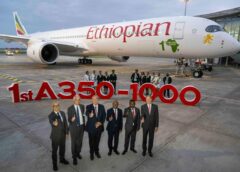Ethiopian Airlines, the undisputed leader in African aviation, marks a historic milestone with the acquisition of the very first Airbus A350-1000 on the African continent. The aircraft, christened “Ethiopia: Land of Origins,” was officially handed over during a solemn ceremony in Toulouse, Airbus’s headquarters in France, ahead of its triumphant arrival scheduled for November 5, 2024, at Addis Ababa’s Bole International Airport.
A Rapidly Expanding Fleet
This delivery is part of an ambitious development strategy, as evidenced by the impressive order of 124 new aircraft announced by the carrier. The A350-1000, an extended and optimized version of the A350 family, represents a significant advancement in terms of capacity and comfort. Capable of accommodating up to 395 passengers split between business and economy classes, this next-generation aircraft notably features a more spacious business section compared to the company’s current wide-body configurations.
This acquisition coincides with Prime Minister Abiy Ahmed’s major announcement regarding the construction of a mega-airport in Ethiopia. This massive infrastructure, with a planned annual capacity of 130 million passengers – quadrupling that of the current Bole airport – clearly positions Ethiopia as a major global aviation hub.
A Modern, Eco-Responsible Fleet and Strengthened Continental Leadership
The A350-1000 joins Ethiopian Airlines’ already impressive fleet, which includes Airbus A350-900s and Boeing 787 Dreamliners. These aircraft, known for their energy efficiency and long-haul performance, demonstrate the company’s commitment to more sustainable aviation.
This new acquisition consolidates Ethiopian Airlines’ position as Africa’s largest airline, not only in terms of fleet size but also infrastructure. It demonstrates the carrier’s ability to maintain its growth trajectory while staying at the forefront of aviation technology.
The combination of this ultra-modern fleet and the future mega-airport strategically positions Ethiopian Airlines to meet the growing demand for air transport in Africa and strengthen its role as an air bridge between the African continent and the rest of the world.






